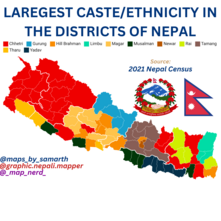Demographics of Nepal
This difference is due to a lack of delivery assistance services in rural communities compared to their urban counterparts who have better access to hospitals and neonatal clinics.[9] There was a moderate amount of immigration early in Nepal's history, then the population essentially remained the same without any significant fluctuations for over one hundred years.[19] Children who spoke Nepali natively and who were exposed to Sanskrit had much better chances[citation needed] of passing the national examinations at the end of high school, which meant they had better employment prospects and could continue into higher education.Children who natively spoke local languages of the Madhesh and Hills, or Tibetan dialects prevailing in the high mountains were at a considerable disadvantage.This history of exclusion coupled with poor prospects for improvement created grievances that encouraged many in ethnic communities such as Madhesi and Tharu in the Tharuhat and Madhesh and Kham Magar in the mid-western hills to support the Unified Communist Party of Nepal (Maoist) and various other armed Maoist opposition groups such as the JTMM during and after the Nepali Civil War.Specifically, Brahmin women experience less equality due to their predominately rural living conditions which deprives them of access to certain educational and healthcare advantages.However, there are some major languages spoken by indigenous peoples in the region: Magar and Gurung in the west-central hills, Tamang in the east-centre and Limbu in the east.[31] In the northwestern region of the country, this all-encompassing state of disorder in the world is synonymous with human affliction, which the religious shamans are believed to alleviate.[31] Individual homes typically have at least one shrine devoted to personal deities, with an altar displaying flowers, fruit, and oil among other offerings to the Gods.[30] The perimeter of Kathmandu Valley is lined with shrines devoted to Hindu goddesses, whose purpose is to protect the city from chaotic events.[30] The people of Nepal do not feel the need to segregate or compete based upon religion, so Hindu and Buddhist shrines are often coexisting in the same areas.On May 19, 2006, the government faced a constitutional crisis, the House of Representatives which had been just reformed, having been previously dissolved, declared Nepal a "secular state".Large groups of Nepali people can be found in Shek Kong and Yuen Long District off of the main bases of the British army.Nepali migrants abroad have suffered tremendous hardships, including some 7,500 deaths in the Middle East and Malaysia alone since the year 2000, some 3,500 in Saudi Arabia.








Population pyramidNepali2021 censusbirth rateinfant mortalityLife expectancymortality rateNet migration rateliteratemigrationUN DESAChhetriTamangMuslimGorkhasMagar MenKhaijadiEthnic groups in NepalSanskritMadheshMadhesiTharuhatKham MagarUnified Communist Party of Nepal (Maoist)Nepali Civil WarGyanendragender perspectiveLanguages of NepalMaithiliBhojpuriBajjikaDoteliAwadhiGurungIndo-AryanTibeto-Burman languagesindigenous languageDevanagariNepal BhasaKathmandu ValleyByangsiHinduismBuddhismKirat MundhumChristianityBuddhistKiratist/YumaistChristianConstitution of NepalVishnuconstitutional crisissecular statesyncreticanimistGurkhasNon-Resident NepaliNepalese BritishOffice for National StatisticsSouth Asians in Hong KongBritish ArmyBrigade of GurkhashandoverShek KongYuen Long Districtright of abodesecurityKiratiethnic groupsHong KongSingaporeMiddle EastMalaysiaSaudi ArabiaAustraliaUnited StatesUnited KingdomSouth KoreaCanadaBibcodeUnited Nations Department of Economic and Social Affairs Population DivisionUnited Nations Population DivisionUnited Nations Department of Economic and Social Affairs, Population DivisionWayback MachineKathmanduStatistics Canadalanguage familySino-TibetanTibeticDarchula BhotiyaBhotiyaSherpaHyolmoCentral TibeticCentral TibetansKacheeKirantiBahingSunuwarKhambu RaiKulungBantawaLohorungYakkhaLimbu (Yakthung)TamangicChhantyalManangeLama clan (Tamang)ThakaliThangmiKham/PangChepangBhujelLepcha (Rong)DhimalPaharispeakersPalpaliGorkhaliKumaunisKashmirisMadheshiMaithilMaithil BrahminKayasthaDhanuk


